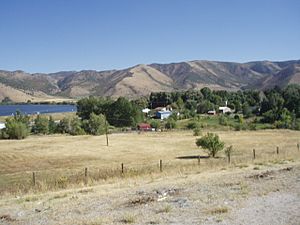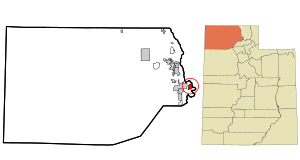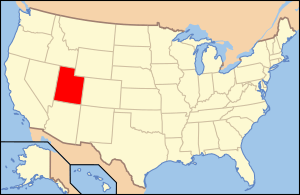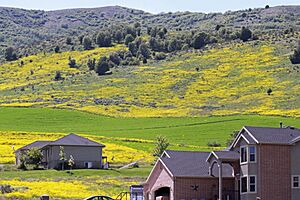Mantua, Utah facts for kids
Quick facts for kids
Mantua, Utah
|
|
|---|---|

Mantua, as seen from US-89/US-91, September 2008
|
|

Location of Mantua within Box Elder County and within the State of Utah
|
|

Location of Utah within the United States
|
|
| Country | United States |
| State | Utah |
| County | Box Elder |
| Settled | 1863 |
| Incorporated | 1911 |
| Named for | Mantua, Ohio |
| Government | |
| • Type | Mayor/Council |
| Area | |
| • Total | 5.70 sq mi (14.8 km2) |
| • Land | 4.91 sq mi (12.7 km2) |
| • Water | 0.79 sq mi (2.0 km2) |
| Elevation | 5,164 ft (1,574 m) |
| Population
(2020)
|
|
| • Total | 1,090 |
| • Density | 196.25/sq mi (75.77/km2) |
| Time zone | UTC-7 (Mountain Time Zone) |
| • Summer (DST) | UTC-6 (MDT) |
| ZIP code |
84324
|
| Area code(s) | 435 |
| FIPS code | 49-47840 |
| GNIS feature ID | 2412947 |
Mantua is a town located on the eastern side of Box Elder County, Utah, in the United States. In 2020, about 1,090 people lived there. It is known for its beautiful natural setting and the Mantua Reservoir.
Contents
Discovering Mantua's Past
Mantua was first settled in the mid-1800s. People from the Church of Jesus Christ of Latter-day Saints were sent to this valley. Their goal was to grow flax, a plant used to make fabric.
The first group of settlers arrived in 1863. They were led by Hans Jens Jensen and came from Denmark. The town was named after Mantua, Ohio. This was done to honor Lorenzo Snow, who was from that Ohio community.
Over time, the way "Mantua" was said changed. Because of the Danish settlers, it became "man-AWAY" instead of "man-TOO-way." Before it got its current name, the community had many other names. These included Box Elder Valley, Copenhagen, Flaxville, Geneva, Hunsaker Valley, Little Copenhagen, and Little Valley.
Exploring Mantua's Geography
Mantua is located at the start of Box Elder Canyon. It sits around the northern, western, and southern edges of the Mantua Reservoir.
The United States Census Bureau measures land areas. They say the town covers about 5.6 square miles (14.5 square kilometers). Most of this area, about 4.9 square miles (12.7 square kilometers), is land. The rest, about 0.7 square miles (1.8 square kilometers), is water.
Mantua's Climate
Mantua has a type of weather called a dry summer continental climate. This means it has warm, dry summers and cold winters. This climate is sometimes called "Dsa" on climate maps.
Mantua's Population Over Time
The population of Mantua has changed quite a bit since it was settled. In 1870, there were only 184 people living there. The number grew to 791 people by the year 2000.
By the 2020 census, Mantua had a population of 1,090 people. This shows that the town has continued to grow over the years.
Life in Mantua
In the year 2000, there were 791 people living in Mantua. Most households were families with married couples. Many families had children under 18 living with them.
The average household in Mantua had about 3.6 people. The average family had about 4 people. The median age of people in Mantua was 30 years old. This means half the people were younger than 30 and half were older.
All About Mantua Reservoir
The Mantua Reservoir is a very important part of the town. Several natural springs in the valley feed water into it. For example, Maple Spring flows into the reservoir from the south. Other springs flow from the east and north.
In 1959 and 1960, Brigham City created the Mantua Reservoir. They built an earthen dam and a dike around the area. This created the large body of water we see today. Brigham City still owns and manages the reservoir.
The reservoir is open for everyone to enjoy. People can visit for outdoor activities. In colder months, it's a popular spot for ice fishing. Some of the water from the springs is also used for drinking water in Brigham City.
See also
 In Spanish: Mantua (Utah) para niños
In Spanish: Mantua (Utah) para niños


